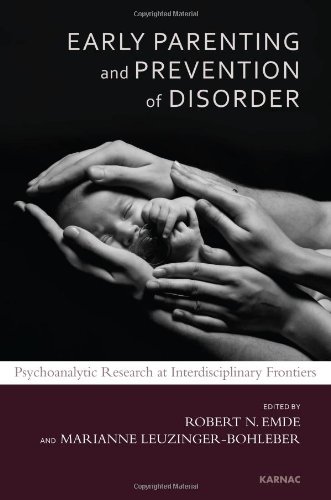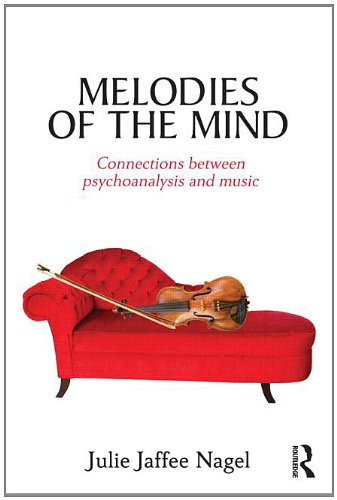Psychoanalysis Books
Winnicott's Babies and Winnicott's Patients: Psychoanalysis as Transitional Space
Winnicott’s thinking continues to grow in importance in psychoanalysis today. This book can be described as a clinical primer: by presenting her own personal responses to Winnicott and her initial... (more)
Cleft Tongue: The Language of Psychic Structures
Cleft Tongue is an attempt to analyse psychic language and its diverse modes of expression, both within psychic structure and in the interpersonal realm. It begins by looking at two basic forms of... (more)
Anxiety and Personality: The Concept of a Directing Object and its Applications
The concept of a "directing object" is based on extensive clinical observations linked to a combination of ego psychology and object relations theory in the tradition of Otto Kernberg and Anne Marie... (more)
On Freud's "A Child is Being Beaten"
Presents a classic essay by Sigmund Freud, followed by discussions that set Freud's work in context and demonstrate its contemporary relevance. The contributors to this volume represent diverse... (more)
Reshaping the Self: Reflections on Renewal Through Therapy
We are organized around the double coordinates of mind-body and self-other, says author Michael Eigen. The story of therapy is, in part, the story of how the unconscious sense of self-other and... (more)
The Fractured Self in Freud and German Philosophy
Sigmund Freud's psychoanalytic theory has deeply affected how we think of ourselves, in emphasizing the limits of consciousness and the impact of irrational forces on our behavior. Philosophers have... (more)
The Talking Cure: Wittgenstein on Language as Bewitchment and Clarity
One of Freud's central claims is that our words and actions reveal unrecognised confusions lying at the heart of our relationships with others and the world. Taking Freud at his word and sharing his... (more)
Interpretive Voices: Responding to Patients
The contributions in this book exemplify ways in which different analysts think about and treat the issue of interpretation, illustrating the distinctiveness with which an analyst expresses his or... (more)
Early Parenting and Prevention of Disorder: Psychoanalytic Research at Interdisciplinary Frontiers
This book provides insight and findings from leading psychoanalysts who are involved in early prevention research and clinical work. Advances in the sciences of early development have brought a... (more)
Self and Emotional Life: Philosophy, Psychoanalysis, and Neuroscience
Adrian Johnston and Catherine Malabou defy theoretical humanities' deeply-entrenched resistance to engagements with the life sciences. Rather than treat biology and its branches as hopelessly... (more)
Forgetting Freud: Is Psychoanalysis in Retreat?
Is psychoanalysis in retreat? Who needs psychoanalysis with its complex theory of the person? Weatherill draws not only on the work of key analytic figures like Freud, Klein and Lacan but also on... (more)
Psychoanalytic Reflections on a Gender-free Case: Into the Void
The past two decades of psychoanalytic discourse have witnessed a marked transformation in the way we think about women and gender. The assignment of gender carries with it a host of assumptions, yet... (more)
Hauntings: Psychoanalysis and Ghostly Transmissions
Hauntings: Psychoanalysis and Ghostly Transmissions shows how the present is troubled by the past and by the future, using the idea of haunting to explore psychoanalytically how identities, beliefs,... (more)
Psychohistoriography: A Post-colonial Psychoanalytical and Psychotherapeutic Model
This book lays out the model of psychohistoriography, which challenges dominant Eurocentric approaches to psychology and mental health, and includes a step by step process which professionals can use... (more)
The Couch in the Marketplace: Psychoanalysis and Social Reality
The book aims at bridging the conceptual and practical gap between a psychoanalytic focus on the internal world and the dynamics of external reality by examining an array of junctures in which the... (more)
Shame and Humiliation: A Dialogue between Psychoanalytic and Systemic Approaches
Shame and Humiliation aims at exploring a sub-set of universal emotions that are usually labelled as "negative" because of the sense of unease that they generate when we experience them and the... (more)
On Sublimation: A Path to the Destiny of Desire, Theory, and Treatment
This book explores and revisits the concept of sublimation, in its various aspects and implications that it has in theory and clinical psychoanalysis, and also in its broader socio-cultural aspects.... (more)
On Freud's "The Unconscious"
If there ever was one word that could represent the essence of Freud’s work, that word would be ‘unconscious’. Indeed, Freud himself regarded his 1915 paper ‘The Unconscious’ as central to clarifying... (more)
Play, Gender, Therapy: Selected Papers of Eleanor Galenson
Eleanor Galenson had a remarkable career whose singular focus was her life-long interest in the maturational and psychosexual vicissitudes of infancy and early childhood. The selection of her... (more)
Shock Head Soul
This brilliant study of psychosis, religious freedom and deluded fanaticism is a moving and unique film based on a real story. In 1903, Daniel Paul Schreber published a shocking and celebrated... (more)
Narcissus in Treatment: The Journey from Fate to Psychological Freedom
This book explores the nature of psychic suffering due to the narcissistic drama and how one can emerge over time to live an autonomous life. The narcissistic drama involves the saga of narcissistic... (more)
Psychoanalytic Filiations: Mapping the Psychoanalytic Movement
This book presents a collection of fifteen essays on the early history of psychoanalysis, focusing on the network of psychoanalytic “filiations” ("who analysed whom") and the context of discovery of... (more)
Psychoanalytic Couple Therapy: Foundations of Theory and Practice
In this time of vulnerable marriages and partnerships, many couples seek help for their relationships. Psychoanalytic couple therapy is a growing application of psychoanalysis for which training is... (more)
Melodies of the Mind: Connections Between Psychoanalysis and Music
What can psychoanalysis learn from music? What can music learn from psychoanalysis? Can the analysis of music itself provide a primary source of psychological data? Drawing on Freud's concept of the... (more)
Love and Loss in Life and in Treatment
Have you ever wondered what a therapist really thinks? Have you ever wondered if a therapist truly cares about her patients? Have you tried to imagine the unimaginable, the loss of the person most... (more)
Paediatrics, Psychiatry and Psychoanalysis: Through Counter-Transference to Case Management
How do children and parents shape clinical practice? How can clinicians learn from the impact of their patients upon them? How do we recognise if health care practices are adversely affecting health... (more)
The Capacity for Ethical Conduct: On Psychic Existence and the Way We Relate to Others - A Psychodynamic Study
What is the root cause of ethical failure? Why is preoccupation with ethics more a part of the problem than a part of the solution? What makes ethical conduct a natural expression of who we are? What... (more)
Catch Them Before They Fall: The Psychoanalysis of Breakdown
In this exploration of a radical approach to the psychoanalytical treatment of people on the verge of mental breakdown, Christopher Bollas offers a new and courageous clinical paradigm.
He... (more)
Metaphor and Fields: Common Ground, Common Language, and the Future of Psychoanalysis
Metaphor and Fields is an explanation and demonstration of the value of metaphoric processes and fields in psychoanalysis. In this book, Montana Katz articulates a future direction for psychoanalysis... (more)
Research on the Couch: Single Case Studies, Subjectivity, and Psychoanalytic Knowledge
Is psychoanalysis knowledge? Is psychoanalysis a science, or is it hermeneutics? Can clinical material be considered research data? Psychoanalysis is ambiguous about whether it is about meaning or... (more)































